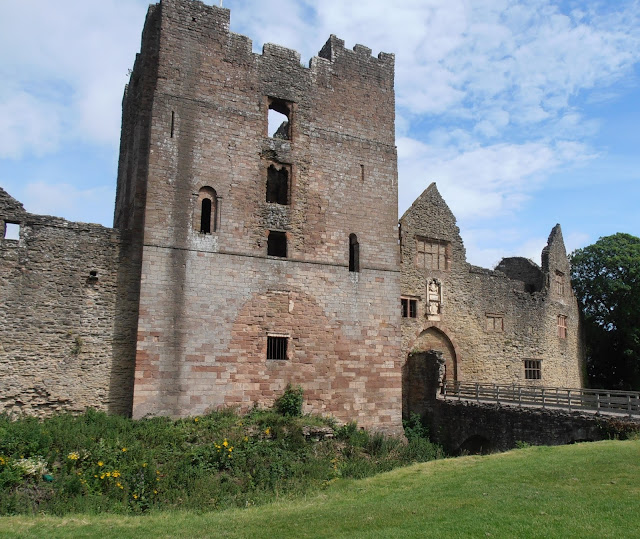Life
in the time of Elizabeth Mortimer and Sir Henry (Hotspur) Percy
By
Anne O’Brien
Elizabeth Mortimer was one of the
powerful medieval Mortimer family that dominated the Welsh Marches where I now
live, surrounded by Mortimer castles. Daughter of Edmund Mortimer, third Earl
of March, and Philippa of Clarence, Elizabeth and her family have become an
interest to me since I moved to live in Herefordshire fifteen years ago.
History has little to say about
Elizabeth. She is no more than a
footnote in the history of her Mortimer menfolk, so why would I choose to write
about her. What would life have been
like for this woman of so notable a family during the first decade of the
fifteenth century?
During Elizabeth's lifetime England underwent
a period of great upheaval. King Richard
II was deposed from the English throne in 1399 by his cousin Henry Bolingbroke,
Duke of Lancaster, who took the throne as King Henry IV, the first of the
Lancastrian Kings. Although Richard was
soon conveniently dead, it did not prove to be a peaceful reign for Henry. Supporters of Richard, claiming that he was
still alive, led plots and insurrection in England, while in Wales the mighty
Owain Glyn Dwr was bidding to become Prince of Wales. With a major battle on English soil at
Shrewsbury in 1403, it was a time of bloody civil war.
Where did Elizabeth fit into this? What
is it that makes her a worthy protagonist for Queen of the North?
 |
| Wigmore Castle, originally the main base of Mortimer power in the Welsh March. |
Great-grand-daughter of King Edward III,
Elizabeth inherited royal Plantagenet blood through her mother Philippa,
daughter of Lionel Duke of Clarence, King Edward III's second surviving
son. Because of this royal connection,
the Mortimer family had a viable claim to the English throne even though it
came through a female line which had been disinherited by Edward III in his
final days. This placed Elizabeth in the
very centre of the struggle for power after the death of Richard II.
As descendents of Edward III's second
son, the Mortimers claimed to take pre-eminence over King Henry IV, descended
from the third son, John of Gaunt. The
young boy Edmund Mortimer, Earl of March, with the strongest claim was
Elizabeth's nephew. King Henry, well
aware of the boy's dangerous bloodline, kept him and his younger brother in
captivity in Windsor Castle. What a compelling
family saga of power and treason, of betrayal and death this promised to be.
 |
| Following in Elizabeth's footsteps: Ludlow Castle's main gateway and the Gatehouse Keep. |
To make Elizabeth's life even more
dynamic, her husband was Sir Henry Percy known to history as Hotspur. I first met them in Shakespeare's Henry IV
where he writes two marvellous scenes for them. It is a relationship full of conflict of
personality but also of wit and love and respect. Elizabeth and Hotspur are a very appealing
couple and dominate the scenes in which they appear. I could not resist writing about them. Hotspur, heir to the Earl of Northumberland,
was such a mercurial and glamorous figure in our history. The perfect hero, brave and courageous,
winning glory on the battlefield, he was also flawed, bringing his own
downfall. He was more than tempting to
write about.
So what was it that threatened to destroy
the tranquillity of Elizabeth's life? The
Percys regarded themselves as Kings in the North, ruling the northern March
between England and Scotland, snatching territory from the Scots whenever
possible. At first Hotspur strongly
supported King Henry, which put Elizabeth and her husband on opposite sides, until
King and Percys came to blows over Henry's interference in Percy authority in
the north and his inability to pay the Percys for their service in providing
troops. This resulted in a showdown
between Henry and Hotspur of major proportions, after which there was no going
back.
And as if this would not make Elizabeth's
life complicated enough, her brother Sir Edmund Mortimer, adult head of the
Mortimers in the Welsh March, was taken captive
in battle by Owain Glyn Dwr's troops.
Kept prisoner, Sir Edmund married one of Glyn Dwr's daughters, changing
sides to become one of the rebels.
 |
| Picture of Ludlow Castle which Elizabeth Mortimer would have known very well. |
Imagine how difficult it must have been
for Elizabeth in the midst of such a keen rivalry for power as she and Hotspur were
drawn deeper into the maelstrom of high politics and betrayal, further
complicated by Glyn Dwr's struggle for hegemony in Wales. All coming to a tragic denouement at the
battle of Shrewsbury where Hotspur and King Henry met in the field. Nor was this the end for Elizabeth. As a Mortimer and a traitor's widow, it would
not be in King Henry's interests to allow her freedom to instigate further rebellion. Elizabeth was left to pay the price for her
treachery.
So why was I compelled to write about Elizabeth? She was a woman who deliberately took on the
role of traitor to the crown in support of her Mortimer nephew. She would know at first hand the resulting
struggle between family loyalty and a desire to pursue what she saw as the
rightful claim to the crown of England, despite all the pain it would bring
her. She would also learn the ultimate
constraints on her freedom, common to all medieval women.
Queen of
the North
tells a marvellous story, of loss and acceptance, of love and tragedy.
Anne O’Brien was born in West Yorkshire. After gaining a BA Honours degree in History at Manchester University and a Master’s in Education at Hull, she lived in East Yorkshire for many years as a teacher of history.
She now lives with her husband in an eighteenth-century timber-framed cottage in the depths of the Welsh Marches in Herefordshire, on the borders between England and Wales, where she writes historical novels. The perfect place in which to bring medieval women back to life.
The Queen of the North
To those around her she was a loyal subject.
In her heart she was a traitor.
1399: England’s crown is under threat. King Richard II holds onto his power by an ever-weakening thread, with exiled Henry of Lancaster back to reclaim his place on the throne.
For Elizabeth Mortimer, there is only one rightful King – her eight-year-old nephew, Edmund. Only he can guarantee her fortunes, and protect her family’s rule over the precious Northern lands bordering Scotland.
But many, including Elizabeth’s husband, do not want another child-King. Elizabeth must hide her true ambitions in Court, and go against her husband’s wishes to help build a rebel army.
To question her loyalty to the King places Elizabeth in the shadow of the axe.
To concede would curdle her Plantagenet blood.
This is one woman’s quest to turn history on its head.
*A word from Mary Anne ~ you can read my review Of Queen of the North here. I Highly Recommend.*




